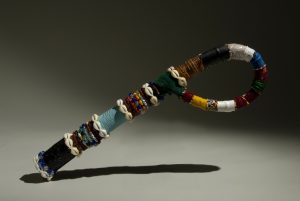 The ibiri, is a scepter-like object carried by the orixa of dance, death, disease and mud; Nanã. Nanã is an orixa of the Brazilian practice of Candomble. The ibiri was said to have been for with Nanã, in the placenta, and the staff itself grew as Nanã aged. However, the staff was placed into the earth, and Nanã was temporarily seperated from it. Until, her son Omolú had found it and brought it back to his mother, and this is what the word ibiri is translated into “Son-found-it- and brought-back-to-me” as found on page 71 in our textbook. The ibiri, is a twin scepter, to the xaxará, the scepter had by Omolú, god of pestilence, and her son. The ibiri is made of a gathered bunch of the ribs of palm fronds, around which is an intricately interwoven net of woven African straw, and adorned with various colored swatches, especially of the colors blue and white, and cowry shells. The colors of blue and white are especially associated with Nanã. The ibiri, is a symbol to the orixa, of when she carried her son in her arms as an infant.
The ibiri, is a scepter-like object carried by the orixa of dance, death, disease and mud; Nanã. Nanã is an orixa of the Brazilian practice of Candomble. The ibiri was said to have been for with Nanã, in the placenta, and the staff itself grew as Nanã aged. However, the staff was placed into the earth, and Nanã was temporarily seperated from it. Until, her son Omolú had found it and brought it back to his mother, and this is what the word ibiri is translated into “Son-found-it- and brought-back-to-me” as found on page 71 in our textbook. The ibiri, is a twin scepter, to the xaxará, the scepter had by Omolú, god of pestilence, and her son. The ibiri is made of a gathered bunch of the ribs of palm fronds, around which is an intricately interwoven net of woven African straw, and adorned with various colored swatches, especially of the colors blue and white, and cowry shells. The colors of blue and white are especially associated with Nanã. The ibiri, is a symbol to the orixa, of when she carried her son in her arms as an infant.
My question is to seek how the ibiri is activated and used in Candomble practices, and how a devotee of Nanã can use the wand and activate its abilities in ritualistic practices. Also, I wish to discover more about the practice of dancing, using the ibiri, as Nanã is also the orixa of dancing, and knowing thus far into our learning of ritualistic practices of black Atlantic religions, how important dancing and motion is in activating not only a religious object, but also the Ashe of the practitioner, during these rituals.
In order to discover more about the answers to my questions, I will consult our textbook primarily, as Nanã is discussed in Chapter One, and the history of the Ibiri and the birth, life, and mythology of the goddess, herself. Also, I will use the library here at UVM to attempt and discover further history and practices of the Ibiri, primarily how it is used in Candomblé practices, but also relations of the Ibiri, and the orixa Nanã with the religious practices, and possible interactions with other deities.